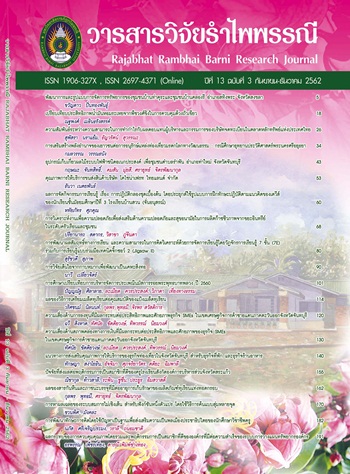เปรียบเทียบประสิทธิภาพน้ำมันหอมระเหยจากพืชวงศ์ขิงในการควบคุม ด้วงถั่วเขียว
Main Article Content
บทคัดย่อ
การเปรียบเทียบประสิทธิภาพของน้ำมันหอมระเหยจากพืชวงศ์ขิง (Zingiberaceae) (ขมิ้นชัน, ขิง, ข่า) ที่กลั่นด้วยความร้อนไอน้ำในการเป็นสารฆ่าด้วงถั่วเขียวอายุ 5-7 วัน โดยการใช้วิธีสัมผัสตายในขวดแก้วที่มีระดับความเข้มข้นร้อยละ 0, 0.5, 1, 1.5, 2, 2.5 และ 3 โดยปริมาตรต่อปริมาตร โดยใช้วิธี
การทดลองแบบสุ่มสมบูรณ์ ผลการทดลองพบว่าน้ำมันหอมระเหยจากขมิ้นชันมีประสิทธิภาพในการเป็นสารฆ่า และการยับยั้งการวางไข่ของด้วงถั่วเขียวสูงสุด เมื่อเปรียบกับสารน้ำมันหอมระเหยจากขิงและข่า ที่ความเข้มข้นร้อยละ 3 ของน้ำมันหอมระเหยจากขมิ้นชันมีประสิทธิภาพในการเป็นสารฆ่าด้วงถั่วเขียวมีร้อยละการตายสูงสุดอยู่ที่ 100% ค่า LC50 เท่ากับร้อยละ 1.41 ที่เวลา 24 ชั่วโมง ในขณะที่น้ำมันหอมระเหยจากขิงและข่ามีร้อยละการตายเท่ากับร้อยละ 66.6 และ 53.3 ตามลำดับ ค่า LC50 เท่ากับร้อยละ 2.38 และ 2.82 ตามลำดับ น้ำมันหอมระเหยจากขมิ้นชันมีร้อยละสูงสุดในการเป็นสารยับยั้งการวางไข่ของด้วงถั่วเขียวเท่ากับร้อยละ 98.17 ในขณะที่น้ำมันหอมระเหยจากขิงและข่ามีร้อยละในการเป็นสารยับยั้งการวางไข่เท่ากับร้อยละ 89.13 และ 89.63 ตามลำดับ
Article Details
References
2. Ali, S., M. Sagheer., M. ul Hassan., M. Abbas., F. Hafeez., M. Farooq., D. Hussain., M. Saleem and A. Ghaffar. (2014). Insecticidal activity of turmeric (Curcuma longa) and garlic (Allium sativum) extracts against red flour beetle, Tribolium castaneum: A safe alternative to insecticides in stored commodities. Journal of Entomology and Zoology Studies. 2(3): 201-205.
3. Asawalam, E.F. and A.L. Chukwuekezie. (2012). Control of maize weevil, Sitophilus zeamais (Motschulsky) using extracts of Gnetum africanum (Afang) leaves and
Curcuma longa l. (Turmeric) rhizomes. International Journal of Agricultural Sciences. 2(9): 263- 265.
4. Bakkali, F., S. Averbeck., D. Averbeck and M. Idaomar. (2008). Biological effects of essential oils – A review. Food and Chemical Toxicology. 46: 446–475.
5. Devi, M.B. and N.V. Devi. (2014). Biology and morphometric measurement of cowpea weevil, Callosobruchus maculatus F.(Coleoptera: Bruchidae) in green gram.
Journal of Entomology and Zoology Studies. 2(3): 74-76.
6. Dey, K.R., P. Choudhury and B.K. Dutta. (2013). Impact of pesticide use on the health of farmers: A study in Barak valley, Assam (India). Journal of Environmental Chemistry and Ecotoxicology. 5(10): 269-277.
7. Dosoky, N.S. and W.N. Setzer. (2018). Chemical composition and biological activities of essential oils of Curcuma species. Nutrients. 10: 1-42.
8. Finney, D.J. (1971). Probit Analysis, 3rd ed. Cambridge University Press, London.
9. Isenring, R. (2010). Pesticides reduce biodiversity. Pesticides news. 88: 4-7.
10. Isman, M.B. (2000). Plant essential oils for pest and disease management. Crop Protection. 9: 603-608.
11. Kahraman, A., M. Adali. M. Onder and N. Koc. (2014). Mung bean [Vigna radiata (L.) Wilczek] as human food. International Journal of Agriculture and Economic Development. 2(2): 9-17.
12. Koul, O., S. Walia and G.S. Dhaliwai. (2008). Essential oils as green pesticides: potential and constraints. Biopesticides International. 4(1): 63–84.
13. Hoi-Seon, L., S. Wook-Kyun., C. Song., C. Kwang-Yun and A. Young-Joon. (2001). Insecticidal activities of ar-Turmerone identified in Curcuma longa rhizome
against Nilaparvata lugens (Homoptera: Delphacidae) and Plutella xylostella (Lepidoptera: Yponomeutidae). Journal of Asia-Pacific Entomology. 4(2): 181-185.
14. Massango, H.G.L.L., L.R.A. Faroni., K. Haddi., F.F Heleno., J.L.O Viteri and E.E. Oliveira. (2017). Toxicity and metabolic mechanisms underlying the insecticidal activity of parsley essential oil on bean weevil, Callosobruchus maculatus. Journal of Pest Science. 90(2): 723-733.
15. Obembe, O.M. and D.O. Ojo. (2018). Toxicity and oviposition inhibitory effect of extract and powder of Momordica charantia leaf against Callosobruchus maculatus
Fab. (Coleoptera: Chrysomelidae) on stored cowpea seed. Journal of Bioscience and Biotechnology Discovery. 3(3): 65-70.
16. Rotimi, J and C.O. Evbuomwan. (2012). Deterrent effects of citrus peel oils on oviposition and adult emergence of the cowpea weevil, Callosobruchus
maculatus (F.) (Coleoptera: Bruchidae). Advances in Applied Science Research. 3(6): 3545-3550.
17. Singh, P. and S.S Jakhmola. (2011). Efficacy of botanical extracts on biological activities of pulse beetle Callosobruchus maculatus (Fab.) on green gram. Trends -in-
Biosciences. 4(1): 25-30.
18. Tachibana, N., S. Wanezaki., M. Nagata., T. Motoyama., M. Kohno and S. Kitagawa. (2013). Intake of mung bean protein isolate reduces plasma triglyceride level
in rats. Functional Foods in Health and Disease. 3(9): 365-376.
19. Talukder, F. (2009). Pesticide resistance in stored-product insects and alternative biorational management: A brief review. Agricultural and Marine Sciences. 14:9-15.
20. Tripathi, A.K., V. Prajapati., N. Verma., J.P. Bahl., R.P. Bansal., S.P.S. Khanuja and S. Kumar. (2002). Bioactivities of the leaf essential oil of Curcuma Longa
(Var. Ch-66) on three species of stored-product beetles (Coleoptera). Journal of Economic Entomology. 95(1): 183-189.
21. Umeozor, O.C. (2005). Effect of the infection of Callosobruchus maculatus (F.) on the weight loss of stored cowpea (Vigna unguiculata (L.) Walp). Journal of Applied Sciences and Environmental Management. 9: 169–172.
22. Upadhyay, R.K. (2012). Insecticidal and oviposition inhibition efficacy of Capparis decidua to Sitophilus oryzae Linn. (Coleoptera: Curculionidae). International Journal of Chemical and Biochemical Sciences. 2: 14-23.
23. Youseif, S.H., F.H.A. El-Megeed and S.A. Saleh. (2017). Improvement of faba bean yield using Rhizobium and Agrobacterium inoculant in low-fertility sandy soil. Agronomy. 7(2): 1-12.

